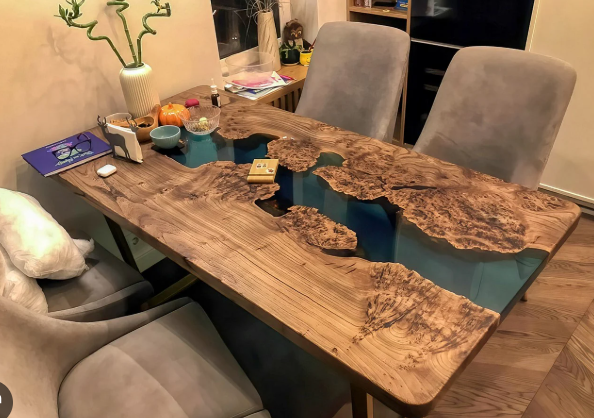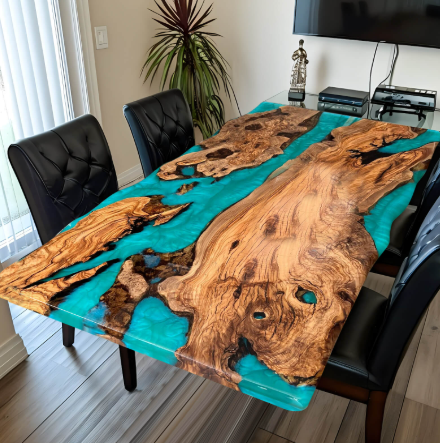
An epoxy resin table can easily become the heart of a home — where people eat, talk, and leave traces of daily life. Over time, it starts to collect memories as much as marks. But like any piece made from wood and resin, it needs a little care to keep that quiet glow that first caught your eye.
Good maintenance isn’t complicated. It’s more about paying attention: wiping a spill before it settles, polishing when it looks dull, and treating the table like something made by hands, not machines. Makers of their best designs often mention that the real secret lies in routine — not fancy products, but small, steady habits that keep the table alive.
Getting to Know Your Table
Epoxy and wood react differently to their surroundings. Wood breathes; it moves a little when seasons change. Resin, on the other hand, stays still and forms a kind of armor. When the air gets too dry or too humid, the two can pull against each other. That’s why a bit of awareness about your home’s temperature and light goes a long way.
Think of your table as a mix of strength and sensitivity. It can take a beating from dinner plates or coffee cups but doesn’t like sudden extremes — heat, cold, or direct sunlight all day long.
Daily Cleaning: The Gentle Way
Dust, fingerprints, and small smudges are part of life. The trick is cleaning without scratching or dulling the surface.
Here’s what works best:
- Wipe with a soft, slightly damp microfiber cloth.
- Stay away from sprays with alcohol, ammonia, or bleach.
- Move your hand in slow circles instead of straight lines — it leaves fewer streaks.
- Dry with another clean cloth before walking away.
If you spill something sticky like wine or sauce, don’t panic. Warm water mixed with a few drops of mild soap is enough. A quick wipe today will save you from stains tomorrow.
Watch Out for Heat
Resin doesn’t melt easily, but it does soften when things get too hot. Setting a steaming pot or mug directly on it can leave a dull ring.
A few simple habits keep trouble away:
- Slip a trivet under hot dishes.
- Use coasters for mugs and glasses.
- Keep laptops, candles, and lamps from sitting too long in one place.
Even a little prevention can spare you those cloudy marks that never seem to polish out.
Scratches: Avoiding the Usual Culprits
No one plans to scratch a table. It happens when you drag a bowl across it or slide a laptop with metal feet. Most marks are light and can fade with a gentle polish, but deeper cuts need more attention.
To avoid them:
- Always lift items instead of dragging.
- Skip paper towels; use soft fabric instead.
- Don’t clean with anything abrasive — even a rough sponge can leave trails.
- Put felt pads under decorative pieces if they stay in the same spot.
A few small changes in habit make a huge difference over time.
Restoring the Shine
Every once in a while, the surface might look a bit tired — not scratched, just dull. Bringing it back is easy.
- Wipe away dust and residue.
- Add a small dab of resin-safe wax or carnauba-based polish on a cloth.
- Work it in with small circular motions.
- Buff the area with a dry cloth until it looks smooth and catches the light again.
If the entire tabletop loses its clarity, a furniture specialist can re-buff the resin. It’s a quick process that brings back the glass-like reflection without changing the wood beneath.
Light, Shade, and Air
Light makes resin come alive — but too much of it, especially sunlight, can slowly change the color. Blue resin can turn slightly greenish; clear resin may take on a golden tone. If your table sits near a window, use sheer curtains to soften the rays.
Humidity also matters. When the air gets too dry in winter, wood might shrink a little. When it’s too damp, it can swell. Try to keep your room balanced — a humidifier in cold months or a dehumidifier in summer helps more than people realize.
Handling Small Damages
Little imperfections give furniture personality, but if something really bothers you, here’s how to fix it:
- Tiny scratches: Rub in a few drops of mineral oil, then buff gently.
- Cloudy patches: Polish with non-abrasive compound or even plain white toothpaste, then wipe clean.
- Faint rings: Mix a bit of olive oil and vinegar, dab with a soft cloth, and repeat until the spot fades.
If the damage runs deeper — like a chip or a melted spot — leave it to a restorer. They can fill and re-level the resin without disturbing the original pattern of the wood.
Keeping It Safe Long Term
People often think “maintenance” means constant effort. It doesn’t. It’s more about quiet attention. A few steady routines will let your table age gracefully.
- Wipe spills quickly.
- Polish twice a year — no more, no less.
- Rotate decorations to prevent uneven fading.
- Avoid placing potted plants directly on the table unless there’s a protective tray.
- Cover lightly if the table won’t be used for a while.
The key is rhythm, not perfection. Over-cleaning or polishing too often can do more harm than good.
Why Small Acts Matter
Every table develops a character — faint marks where someone rested a cup, the soft change in tone after years near a window. These details aren’t flaws; they’re proof of life. Care is not about freezing the table in time but letting it grow older with grace.
The reward for that effort is subtle: when sunlight hits it one morning and you see both the grain and the resin glimmer quietly, you’ll know it was worth every careful wipe.
Common Mistakes to Avoid
- Glass cleaner: It might seem safe but slowly fogs resin.
- Soaking wet cloths: Too much moisture seeps into the wood joints.
- Plastic covers: They trap heat and moisture, leaving a tacky feel.
- Polishing too frequently: Residue builds up and dulls the surface.
- Leaving heavy objects for months: Pressure marks can form under them.
Most of these are easy to dodge once you know what to look out for.
When to Ask for Help
Sometimes, despite your best efforts, the table needs professional attention — for example, when a deep crack forms or a burn mark shows up. Professionals can re-sand and re-pour resin in only the affected area, matching color and clarity so it’s invisible afterward.
If you ever end up with a heat ring or a dark patch and want to handle it yourself, check out this article. It walks through the practical steps of treating burn marks safely at home before calling in an expert.

A Table That Grows With You
With steady care, an epoxy resin table becomes part of your story. It changes slowly — the wood deepens in color, the resin reflects light differently as years go by. Every mark holds a trace of a shared meal or conversation. That’s not wear; that’s memory.
Treat it kindly, and it will stay with you for decades, aging the way good things do — quietly, with character.







(0) comments
We welcome your comments
Log In
Post a comment as Guest
Keep it Clean. Please avoid obscene, vulgar, lewd, racist or sexually-oriented language.
PLEASE TURN OFF YOUR CAPS LOCK.
Don't Threaten. Threats of harming another person will not be tolerated.
Be Truthful. Don't knowingly lie about anyone or anything.
Be Nice. No racism, sexism or any sort of -ism that is degrading to another person.
Be Proactive. Use the 'Report' link on each comment to let us know of abusive posts.
Share with Us. We'd love to hear eyewitness accounts, the history behind an article.